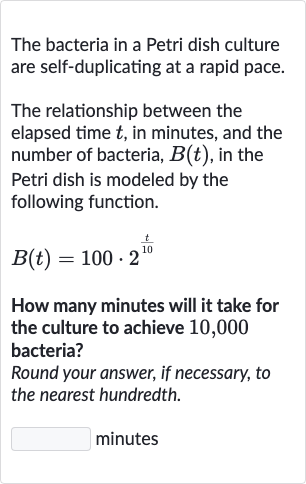AI tutor
Welcome to Bytelearn!
Let’s check out your problem:

The bacteria in a Petri dish culture are self-duplicating at a rapid pace.The relationship between the elapsed time , in minutes, and the number of bacteria, , in the Petri dish is modeled by the following function.How many minutes will it take for the culture to achieve , bacteria?Round your answer, if necessary, to the nearest hundredth.minutes
Full solution
Q. The bacteria in a Petri dish culture are self-duplicating at a rapid pace.The relationship between the elapsed time , in minutes, and the number of bacteria, , in the Petri dish is modeled by the following function.How many minutes will it take for the culture to achieve , bacteria?Round your answer, if necessary, to the nearest hundredth.minutes
- Given Function: We are given the function and we need to find the time when . We can set up the equation and solve for .
- Isolate Exponential Term: Divide both sides of the equation by to isolate the exponential term on one side. This gives us .
- Simplify Equation: Simplify the left side of the equation to get .
- Take Logarithm: To solve for , we need to take the logarithm of both sides. We will use the base logarithm because the base of the exponent is . This gives us .
- Calculate Logarithm: Using the property of logarithms that , we can simplify the right side to get .
- Solve for : Now we need to calculate . Since and , is between and . We can use a calculator to find the exact value.
- Round Final Answer: Using a calculator, we find that is approximately . So we have .
- Round Final Answer: Using a calculator, we find that is approximately . So we have .Multiply both sides of the equation by to solve for . This gives us .
- Round Final Answer: Using a calculator, we find that is approximately . So we have . Multiply both sides of the equation by to solve for . This gives us . Calculate the value of by multiplying by to get .
- Round Final Answer: Using a calculator, we find that is approximately . So we have .Multiply both sides of the equation by to solve for . This gives us .Calculate the value of by multiplying by to get .Round the answer to the nearest hundredth as requested. The rounded value of is minutes.
